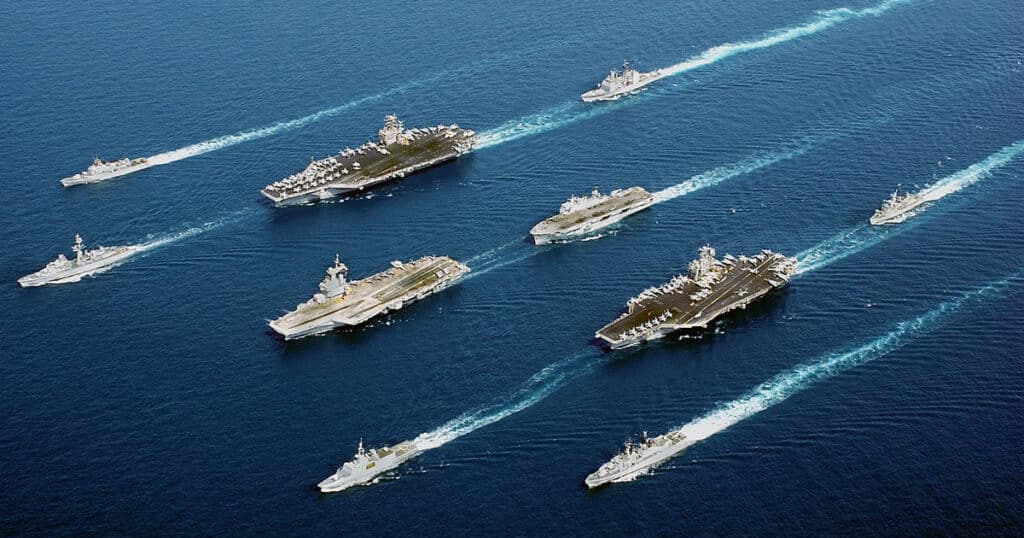
Strengthening Our Beleaguered Military Starts With a Maritime Overhaul
America’s security and prosperity is at high risk today, largely because of bad policies backed up by too weak armed forces. Consider our U.S. maritime complex. Decades of neglect and inadequate investment have left our shipping, shipbuilding, Navy, merchant marines, ports, and Coast Guard woefully behind the times. The Secretary of the Navy and a growing group in Congress are sounding the alarm, drawing attention to the plight of our weakened maritime sector.
Recent headlines help tell the story. Since October 2023, the Navy has been engaged in a ‘whack-a-mole’ standoff with the Houthis, an Iranian proxy that has been attacking vessels in the Red Sea and damaging global trade. This confrontation expanded to include missile defense of Israel, culminating on April 13 with the shoot-down of several Iranian ballistic missiles targeting Israel by destroyers Arleigh Burke and Carney.
This defensive effort is depleting expensive munitions that are in short supply. The Secretary of the Navy stated before Congress on April 15 that the Navy has responded to 130 attacks at a cost of $1 billion in munitions. At current procurement rates, it could take years to recover unless production capacity is greatly expanded in short order.
Closer to home, on March 26 a container ship (the Dali) lost power and collided with, and collapsed the Key Bridge in Baltimore, killing six. The investigation is ongoing, but already it is clear our port infrastructure is not resilient enough to withstand errant modern shipping. Neither the Army Corps of Engineers nor Naval salvage capacity is adequate. Both have been unable to ensure the nation’s ports can be rapidly reopened if closed due to deliberate acts, accidents or acts of God.
A month later, the port of Baltimore remains closed. For comparison, when the ultra-large containership Ever Given grounded and closed the Suez Canal, it was reopened in eight days. Effectively, the Dali has stranded four Navy logistics ships inside the harbor unable to meet national tasking – ships verified still stuck in port on April 29th.
Finally, in a string of embarrassing events, the large amphibious warship Boxer had to return home, further delaying its deployment due to numerous and repeated mechanical problems. This means other warships must remain at-sea longer or forgo missions, further endangering U.S. interests. As this was playing out, ships directed by the President to assist in the delivery of aid to Gaza, had to turn back due to onboard fires (the venerable 39-year old Military Sealift Command ship 2nd Lt. John P. Bobo), too short endurance (Army’s Frank Besson Jr. refueling stop in the Azores), or weather avoidance (the likely reason USAV Wilson Wharf diverted to Tenerife). These disruptions are a symptom of a too small and aged fleet that has been over-used and under-maintained by over-worked crews.
The root cause of these problems? Sea blindness – unawareness and underinvestment in the maritime and naval forces that keep the economy functioning and our people safe.
But there are signs this may be changing. More Americans are demanding action, and members of Congress like Rep. Michael Waltz (R-Fla.) and Sen. Mark Kelly (D-Ariz.) are spearheading a bipartisan and bicameral maritime agenda. The opening declaration of this was contained in a recent letter to the President demanding action signed by 19 Congressional leaders from both parties.
The challenge is huge. Today only 0.4 percent of commercial shipping is American flagged, making the nation too often reliant on less than friendly nations to conduct its trade and move supplies sustaining military operations. But these tentative first steps are just a downpayment on a larger endeavor: regaining the nation’s maritime strength.
The most urgent task is keeping the peace, and that means deterring China in Asia while safeguarding Americans and our interests abroad. The clock has run out for modest, long-term actions. The threat today demands a combination of actions: retaining useful warships, expanding maritime industrial capacity, and accelerating naval shipbuilding.
This will be an expansive task, to be sure, but it is not revolutionary, nor is it impossible. Three past naval revivals can help point the way ahead.
One dates back a little over 100 years ago. Britain’s First Sea Lord Admiral Sir John “Jackie” Fisher’s fleet modernization is what some today call “divest to invest” – the culling of outdated ships to redirect manpower and resources to delivering modern warships. At the time, the British Royal Navy had a still modest naval rival in the Imperial German Navy that was a decade or more away from achieving parity with the British fleet.
Fisher’s efforts delivered the Dreadnaught – a warship that ushered in the modern battleship and revolutionized naval warfare, as demonstrated at the 1916 Battle of Jutland. Fisher had the time and commitment of resources by a nation with a long, proud, and politically dominant naval tradition behind him. He also had the luxury of a foe years from matching or exceeding his own fleet. China’s navy, by contrast, already exceeds ours and continues a breakneck modernization and readiness program that makes any U.S. divestment of naval capacity a strategic risk.
The second revival was America’s rearming ahead of the war in the Pacific, made possible by several Naval Acts of the 1930s. Animating this revival was the still fresh memories of a near catastrophe during World War I.
As that war raged in Europe, the nation’s economy was nearly collapsed without foreign shipping to carry its cargo to market, nor ships to move troops to Europe and back. One intent of the 1930s Naval Acts was to avoid the mismanagement and waste of the Shipping Act of 1916 and the U.S. Shipping Board. With that wisdom, the Acts of the 1930s funded a naval building campaign that invigorated the maritime industrial sector. Thanks to the Naval Act of 1938, the carrier Hornet was delivered in time to play an instrumental role in the victory in the Battle of Midway. The ships these naval acts authorized quadruple the number of shipyards and delivered in the first years of World War II the warships that turned the tide against the Axis. Had it not been done, the war in the Pacific would have had a very different outcome.
A modern Naval Act is needed, but it cannot be limited to just considerations of naval shipbuilding. It must embrace efforts to rebuild the nation’s merchant fleet that today couldn’t sustain protracted military operations nor a wartime economy.
Finally, President Ronald Reagan’s 600-ship naval build-up of the 1980s significantly contributed to bankrupting the Soviets and winning the Cold War. The shipbuilding goal was never achieved, but a massive rebuilding effort was accomplished by increasing defense budgets disproportionately directed to naval shipbuilding and the return to service of ships in the inactive fleet. In total, the combination of new shipbuilding and reactivation grew the Navy from a low of 521 ships in 1981 to 594 in six years.
Today there isn’t really much in the inactive fleet to recall to service. Leading to circumstances that today dictate retaining ships on the Navy’s list for deactivation with more than three years of life, thereby adding 13 warships to the fleet. Furthermore, the fleet could grow a little more with the addition of 21 deployable unmanned (LUSV, MUSV, XLUUV) vessels. This would deliver a fleet of 331 warships by 2027, still short of the 355-fleet goal. To address that gap, conventional approaches to get the Navy and merchant marine needed will not suffice.
The reality today is that the nation faces multiple threats and at least one existential foe taking increasing risks to reorder the world to its benefit: China. Pacing these challenges has proven inadequate. It is time to seriously enter the race to secure American security and prosperity, which begins with a national effort to rejuvenate our maritime power. Recovering and meeting the threats before the nation requires a multifaceted but coherent plan of attack – a National Maritime Initiative.
This is critical as the Navy’s ships suffer from years of over work, sailors beaten down under unrelenting prolonged deployments, and an inconsequential U.S. flagged merchant marine. We are in effect living in an “AND” world where spending is needed to grow the maritime industrial base through orders for new warships learned during the Naval Acts era, AND modernizing but without divesting, AND retaining warships with life, AND dramatically increasing naval shipbuilding as done during the Reagan era.
Anything less is unserious and ignores the world as it is today.
Brent D. Sadler is a senior research fellow in naval warfare and advanced technologies at The Heritage Foundation.
This article was originally published by RealClearDefense and made available via RealClearWire.



